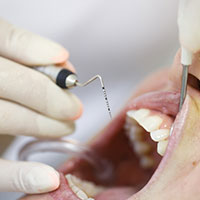 Can you remember your last dental checkup?
Can you remember your last dental checkup?
If so, think back to when the dentist was poking your gums with a small metal instrument while calling out seemingly random numbers to his dental assistant.
You were getting an exam called a “periodontal charting,” also known as “gum measurements.” The purpose of it is to determine the health of your gums the amount of gum tissue around each tooth. There are six sides around each tooth, which means you probably heard a lot of numbers being called out.
If you’ve ever wondered what was going on during this exam, we’re going to look at the overall process of measuring your gums and looking at what the numbers mean.
Gum Measurements
A gum evaluation is usually performed when you get your teeth cleaned. The purpose of it is to measure the depth and health of your gums. They’re measured in millimeters in accordance with the following chart:
- 0 to 3mm (no bleeding): Perfectly healthy gums
- 1 to 3mm (with bleeding): You’ve got gingivitis. Fortunately, it’s the mildest form of gum disease and can improve provided that you brush your teeth daily.
- 3 to 5mm (no bleeding): This is the cusp where gum disease starts. A dental cleaning cannot go deeper than 3 mm, so you’ll probably be required to visit the dentist at least 4x per year to improve your gum health.
- 3 to 5mm (with bleeding): This is the stage where moderate gum disease begins. Better oral care and more regular dental cleanings will be required.
- 7mm and up (with bleeding): You’ve got advanced periodontal disease. Surgery will most likely be needed to fix the problem, along with dental cleaning every three to four months.
How Is It Performed?
A groove exists between your gums and your teeth. To check for gum depth, the dentist will use a specialized small metal probe. It will measure how far it goes into your gums in millimeters. Each tooth has six different areas that need to be measured.
As the dentist starts the measurements, he will call out the depth numbers to his assistant who will log the information on a chart or hand-held tablet. In some cases, he might require a dental X-ray to check for bone loss where deeper pockets are observed.
Treatment Options
There are several surgical and non-surgical treatment options if your gum measurements go over 5mm. The dentist will recommend one or the other based on the current state of your gums.
Non-Surgical
If the gum disease is not advanced, non-surgical treatment is an option. There are three ways to go about it:
- Root planning – This procedure will smooth the root surface and discourage the buildup of bacteria and tartar. It’s a super deep teeth cleaning process.
- Scaling – Bacteria and tartar are manually removed from your mouth by metal instruments or in some cases a laser.
- Antibiotics – Oral or topical antibiotics can lower the bacteria counts in your mouth. The dentist might prescribe an oral mouth rinse or gels to help fight the infection caused by the bacteria.
Surgical
For those who have advanced periodontitis, surgery might be the only way to treat the problem.
- Soft tissue grafts – When your mouth loses gum tissue, the gumline will recede. A soft tissue graft is performed by removing a small amount of tissue from the roof of your mouth and transplanting it to the damage site.
- Flap surgery – Small incisions will be made in your gums so that the dentist can perform an even deeper root planing and scaling procedure. Once you’re healed up sufficiently, the entire area will be much easier to clean.
- Tissue regeneration – If you had bone that was destroyed by bacteria, this procedure would help regrow it. A piece of biocompatible fabric is placed in between your tooth and the bone which keeps the gums from intruding and allows the bone to grow back.
How to Reduce Periodontitis?
In some cases, surgery is the only way gum disease can be reduced or eliminated. However, you can do your part in the fight by adopting a more regular oral care schedule.
Try brushing and flossing your teeth on a daily basis and limit the number of sugars and other unhealthy foods that you consume. Mouth rinse (either prescribed or over-the-counter) can also help reduce the number of bacteria inside your mouth.
You should also schedule more regular teeth cleanings. Brushing and flossing alone will not prevent plaque, tartar, and other yucky stuff from forming in hard-to-reach areas inside your mouth. A professional dental cleaning every four months can help remove plaque and tartar and keep your gums and teeth healthy.
Dental Checkups in Chicago
If you haven’t had a dental cleaning or checkup in a while and you haven’t been brushing and flossing on a regular basis, you should schedule an appointment to see us as soon as possible.
At Water Tower Dental Care, we specialize in helping our patients improve their oral health. Our caring and gentle dentists will help you make your smile look like a million bucks!






 Website Powered by Sesame 24-7™
Website Powered by Sesame 24-7™